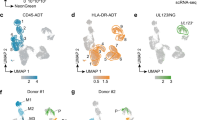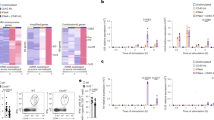Abstract
Immature dendritic cells are among the first cells infected by retroviruses after mucosal exposure. We explored the effects of human immunodeficiency virus-1 (HIV-1) and its Tat transactivator on these primary antigen-presenting cells using DNA microarray analysis and functional assays. We found that HIV-1 infection or Tat expression induces interferon (IFN)-responsive gene expression in immature human dendritic cells without inducing maturation. Among the induced gene products are chemokines that recruit activated T cells and macrophages, the ultimate target cells for the virus. Dendritic cells in the lymph nodes of macaques infected with simian immunodeficiency virus (SIV) have elevated levels of monocyte chemoattractant protein 2 (MCP-2), demonstrating that chemokine induction also occurs during retroviral infection in vivo. These results show that HIV-1 Tat reprograms host dendritic cell gene expression to facilitate expansion of HIV-1 infection.
This is a preview of subscription content, access via your institution
Access options
Subscribe to this journal
Receive 12 print issues and online access
$209.00 per year
only $17.42 per issue
Buy this article
- Purchase on Springer Link
- Instant access to full article PDF
Prices may be subject to local taxes which are calculated during checkout





Similar content being viewed by others
Change history
22 January 2003
This is a significant change only. The supp info pdf was incorrectly formatted so the columns weren't lining up correctly. Editorial supplied a correctly formatted pdf.
References
Stahl-Hennig, C. et al. Rapid infection of oral mucosal-associated lymphoid tissue with simian immunodeficiency virus. Science 285, 1261–1265 (1999).
Zhang, Z. et al. Sexual transmission and propagation of SIV and HIV in resting and activated CD4+ T cells. Science 286, 1353–1357 (1999).
Granelli-Piperno, A., Delgado, E., Finkel, V., Paxton, W. & Steinman, R.M. Immature dendritic cells selectively replicate macrophagetropic (M-tropic) human immunodeficiency virus type 1, while mature cells efficiently transmit both M- and T-tropic virus to T cells. J. Virol. 72, 2733–2737 (1998).
Hu, J., Gardner, M.B. & Miller, C.J. Simian immunodeficiency virus rapidly penetrates the cervicovaginal mucosa after intravaginal inoculation and infects intraepithelial dendritic cells. J. Virol. 74, 6087–6095 (2000).
Rescigno, M. et al. Dendritic cells express tight junction proteins and penetrate gut epithelial monolayers to sample bacteria. Nat. Immunol. 2, 361–367 (2001).
Geijtenbeek, T.B. et al. DC-SIGN, a dendritic cell-specific HIV-1-binding protein that enhances trans-infection of T cells. Cell 100, 587–597 (2000).
Banchereau, J. et al. Immunobiology of dendritic cells. Annu. Rev. Immunol. 18, 767–811 (2000).
Mellman, I. & Steinman, R.M. Dendritic cells: specialized and regulated antigen processing machines. Cell 106, 255–258 (2001).
Huang, Q. et al. The plasticity of dendritic cell responses to pathogens and their components. Science 294, 870–875 (2001).
Tortorella, D., Gewurz, B.E., Furman, M.H., Schust, D.J. & Ploegh, H.L. Viral subversion of the immune system. Annu. Rev. Immunol. 18, 861–926 (2000).
Engelmayer, J. et al. Vaccinia virus inhibits the maturation of human dendritic cells: a novel mechanism of immune evasion. J. Immunol. 163, 6762–6768 (1999).
Grosjean, I. et al. Measles virus infects human dendritic cells and blocks their allostimulatory properties for CD4+ T cells. J. Exp. Med. 186, 801–812 (1997).
de Noronha, C.M. et al. Dynamic disruptions in nuclear envelope architecture and integrity induced by HIV-1 Vpr. Science 294, 1105–1108 (2001).
Viscidi, R.P., Mayur, K., Lederman, H.M. & Frankel, A.D. Inhibition of antigen-induced lymphocyte proliferation by Tat protein from HIV-1. Science 246, 1606–1608 (1989).
New, D.R., Ma, M., Epstein, L.G., Nath, A. & Gelbard, H.A. Human immunodeficiency virus type 1 Tat protein induces death by apoptosis in primary human neuron cultures. J. Neurovirol. 3, 168–173 (1997).
Swingler, S. et al. HIV-1 Nef mediates lymphocyte chemotaxis and activation by infected macrophages. Nature Med. 5, 997–1103 (1999).
Simmons, A., Aluvihare, V. & McMichael, A. Nef triggers a transcriptional program in T cells imitating single-signal T cell activation and inducing HIV virulence mediators. Immunity 14, 763–777 (2001).
Messner, D. et al. Endogenously expressed nef uncouples cytokine and chemokine prouction from membrane phenotypic maturation in dendritic cells. J. Immunol. 169, 4172–4182 (2002).
Wu, Y. & Marsh, J.W. Selective transcription and modulation of resting T cell activity by preintegrated HIV DNA. Science 293, 1503–1506 (2001).
Jones, K.A. Taking a new TAK on tat transactivation. Genes Dev. 11, 2593–2599 (1997).
Demarchi, F., Gutierrez, M.I. & Giacca, M. Human immunodeficiency virus type 1 tat protein activates transcription factor NF-κB through the cellular interferon-inducible, double-stranded RNA-dependent protein kinase, PKR. J. Virol. 73, 7080–7086 (1999).
Marzio, G. & Giacca, M. Chromatin control of HIV-1 gene expression. Genetica 106, 125–130 (1999).
Chartier, C. et al. Efficient generation of recombinant adenovirus vectors by homologous recombination in Escherichia coli. J. Virol. 70, 4805–4810 (1996).
Zhang, L. & Pagano, J.S. Review: structure and function of IRF-7. J. Interferon Cytokine Res. 22, 95–101 (2002).
Ramana, C.V., Gil, M.P., Schreiber, R.D. & Stark, G.R. Stat1-dependent and -independent pathways in IFN-γ-dependent signaling. Trends Immunol. 23, 96–101 (2002).
Bazan, J.F. et al. A new class of membrane-bound chemokine with a CX3C motif. Nature 385, 640–644 (1997).
Luster, A.D., Unkeless, J.C. & Ravetch, J.V. γ-interferon transcriptionally regulates an early-response gene containing homology to platelet proteins. Nature 315, 672–676 (1985).
Piali, L. et al. The chemokine receptor CXCR3 mediates rapid and shear-resistant adhesion-induction of effector T lymphocytes by the chemokines IP10 and Mig. Eur. J. Immunol. 28, 961–972 (1998).
Van Damme, J., Proost, P., Lenaerts, J.P. & Opdenakker, G. Structural and functional identification of two human, tumor-derived monocyte chemotactic proteins (MCP-2 and MCP-3) belonging to the chemokine family. J. Exp. Med. 176, 59–65 (1992).
Wu, L. et al. Rhesus macaque dendritic cells efficiently transmit primate lentiviruses independently of DC-SIGN. Proc. Natl. Acad. Sci. USA 99, 1568–1573 (2002).
Smith, S.G., Patel, P.M., Selby, P.J. & Jackson, A.M. The response of human dendritic cells to recombinant adenovirus, recombinant Mycobacterium bovis Bacillus Calmette Guerin and biolistic methods of antigen delivery: different induction of contact-dependant and soluble signals. Immunol. Lett. 76, 79–88 (2001).
Douek, D.C. et al. HIV preferentially infects HIV-specific CD4+ T cells. Nature 417, 95–98 (2002).
Agostini, C. et al. CXC chemokines IP-10 and mig expression and direct migration of pulmonary CD8+/CXCR3+ T cells in the lungs of patients with HIV infection and T-cell alveolitis. Am. J. Respir. Crit. Care Med. 162, 1466–1473 (2000).
Frankel, A.D. & Pabo, C.O. Cellular uptake of the tat protein from human immunodeficiency virus. Cell 55, 1189–1193 (1988).
Sen, G.C. Novel functions of interferon-induced proteins. Semin. Cancer Biol. 10, 93–101 (2000).
Chang, Y.E. & Laimins, L.A. Microarray analysis identifies interferon-inducible genes and Stat-1 as major transcriptional targets of human papillomavirus type 31. J. Virol. 74, 4174–4182 (2000).
Fujii, N., Yokosawa, N. & Shirakawa, S. Suppression of interferon response gene expression in cells persistently infected with mumps virus, and restoration from its suppression by treatment with ribavirin. Virus Res. 65, 175–185 (1999).
Weihua, X. et al. The polyoma virus T antigen interferes with interferon-inducible gene expression. Proc. Natl. Acad. Sci. USA 95, 1085–1090 (1998).
Miura, Y. et al. Critical contribution of tumor necrosis factor-related apoptosis-inducing ligand (TRAIL) to apoptosis of human CD4+ T cells in HIV-1-infected hu-PBL-NOD-SCID mice. J. Exp. Med. 193, 651–660 (2001).
Katsikis, P.D. et al. Interleukin-1 beta converting enzyme-like protease involvement in Fas-induced and activation-induced peripheral blood T cell apoptosis in HIV infection. TNF-related apoptosis-inducing ligand can mediate activation-induced T cell death in HIV infection. J. Exp. Med. 186, 1365–1372 (1997).
Fanales-Belasio, E. et al. Native HIV-1 Tat protein targets monocyte-derived dendritic cells and enhances their maturation, function, and antigen-specific T cell responses. J. Immunol. 168, 197–206 (2002).
Bender, A., Sapp, M., Schuler, G., Steinman, R.M. & Bhardwaj, N. Improved methods for the generation of dendritic cells from nonproliferating progenitors in human blood. J. Immunol. Methods 196, 121–135 (1996).
Liu, Y.J. Dendritic cell subsets and lineages, and their functions in innate and adaptive immunity. Cell 106, 259–262 (2001).
Waldrop, S.L., Pitcher, C.J., Peterson, D.M., Maino, V.C. & Picker, L.J. Determination of antigen-specific memory/effector CD4+ T cell frequencies by flow cytometry: evidence for a novel, antigen-specific homeostatic mechanism in HIV-associated immunodeficiency. J. Clin. Invest. 99, 1739–1750 (1997).
Poon, D.T., Wu, J. & Aldovini, A. Charged amino acid residues of human immunodeficiency virus type 1 nucleocapsid p7 protein involved in RNA packaging and infectivity. J. Virol. 70, 6607–6616 (1996).
Acknowledgements
We thank J.-S. Lee of the Harvard Gene Therapy Initiative Vector Core, supported in part by the Association Française contre les Myopathies, for providing the adeno-LacZ and adeno-Tat viruses; M. Stevenson for the adeno-Nef virus; D. Pokholok, G. Nau, J. Richmond, A. Schlesinger and E. Jennings for discussion and help with data analysis. This work was supported by NIH grants AI41365, AI44476, RR00169 and RR14555.
Author information
Authors and Affiliations
Corresponding author
Ethics declarations
Competing interests
The authors declare no competing financial interests.
Supplementary information
Rights and permissions
About this article
Cite this article
Izmailova, E., Bertley, F., Huang, Q. et al. HIV-1 Tat reprograms immature dendritic cells to express chemoattractants for activated T cells and macrophages. Nat Med 9, 191–197 (2003). https://doi.org/10.1038/nm822
Received:
Accepted:
Published:
Issue Date:
DOI: https://doi.org/10.1038/nm822
This article is cited by
-
New insights into pathogenesis point to HIV-1 Tat as a key vaccine target
Archives of Virology (2021)
-
Genetic variation and function of the HIV-1 Tat protein
Medical Microbiology and Immunology (2019)
-
Production of antigen-specific human IgGs by in vitro immunization
BMC Biotechnology (2016)
-
Transcriptional profiling of the host cell response to feline immunodeficiency virus infection
Virology Journal (2014)
-
HIV-1 Tat second exon limits the extent of Tat-mediated modulation of interferon-stimulated genes in antigen presenting cells
Retrovirology (2014)



